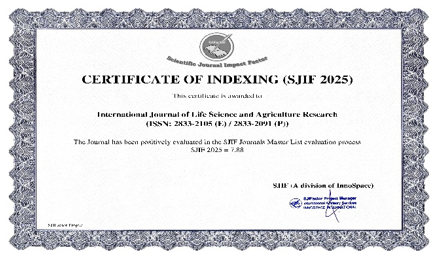Residual Effect of Organic Waste Mulching and Intercropping Aerobic Rice with Peanut on Yield Performance of Mungbean Direct-seeded Following Rice on Raised-beds in Lombok, Indonesia
DOI:
https://doi.org/10.55677/ijlsar/V03I6Y2024-01Keywords:
Aerobic irrigation; intercropping; mungbean; raised-beds; red rice; peanutAbstract
In Indonesia, in the paddy fields, mungbean is generally planted in the dry season as a rotation crop for rice when irrigation water is insufficient for growing rice, so the productivity of mungbean is generally very low. This research aims to determine the impact of cultivation techniques of aerobic-irrigated red rice grown on permanent raised-beds applied with various organic wastes on growth and yield of mungbean direct-seeded following harvest of red rice. The experiment carried out in June-August 2020, was arranged according to Split Plot design, with two treatment factors: techniques of cultivating aerobic-irrigated red rice, as main plots (T1: monocrop; T2: intercropping with peanuts), and application of various organic wastes to the red rice, as subplots (L0: no waste, L1: rice husks, L2: rice husk ash , L3: rice husk ash + cattle manure). The results indicated that techniques of red rice cultivation and application of various wastes to the red rice showed significant interaction effect on pod number and dry filled-pod weight of mungbean direct-seeded following the red rice, in which dry filled-pod weight was highest (14.44 g/clump) in mungbean direct seeded following aerobic-irrigated red rice intercropped with peanuts receiving rice husk ash (T2L2), and lowest (6.74 g/clump) in mungbean direct-seeded following monocropped red rice without organic wastes (T1L0). Both intercropping with peanuts and application of organic wastes to the red rice preceding mungbean, in general, resulted in higher grain yields of mungbean direct-seeded without tillage following harvest of the aerobic-irrigated red rice grown on raised-beds.
References
Bakri, 2008. Kompnen Kimia dan Fisik Abu Sekam Padi Sebagai SCM Untuk Pembuatan Komposit Semen. Jurnal Perennial. 5 (1), 9-14.
Chu, G.X., Q.R. Shen and J.L. Cao. 2004. Nitrogen fixation and N transfer from peanut to rice cultivated in aerobic soil in an intercropping system and its effect on soil N fertility. Plant and Soil 263: 17–27.
Dahiya, P. K., Linnemann, A. R., Van Boekel, M. A. J. S., Khetarpaul, N., Grewal, R. B., & Nout, M. J. R. 2015. Mung bean: Technological and nutritional potential. Critical reviews in food science and nutrition, 55(5), 670-688.
Dulur, N.W.D., Wangiyana, W., Farida, N., Kusnarta, I.G.M., 2020a. Growth and Yield of Soybean Direct-seeded Following Conventional and Aerobic Rice Intercropped with Peanut and Amended with Organic Wastes. International journal of Horticulture, Agriculture and Food Science, 4(5), 189-195.
Dulur, N.W.D., Nasiruddin, M.H., Farida, N., Wangiyana, W., Kusnarta, I.G.M., 2020b. Pengaruh aplikasi limbah organik terhadap pertumbuhan dan hasil kacang hijau pasca padi sistem irigasi aerobik antara monokrop dan tumpangsari dengan kacang tanah. Makalah disampaikan pada Seminar Nasional Peragi UMY, Yogyakarta, 17 Oktober 2020.
Fustec, J., F. Lesuffleur, S. Mahieu, and J. B. Cliquet. 2010. Nitrogen rhizodeposition of legumes. A review. Agronomy for Sustainable Development, 30(1): 57-66.
Inal, A., Gunes, A., Zhang, F., Cakmak, I., 2007. Peanut/maize intercropping induced changes in rhizosphere and nutrient cincentrations in shoots. Plant Physiology and Biochemistry 45(5), 350-356.
Keatinge, J.D.H., Chadha, M.L., Easdown, W.J., Shanmugasundaram, S., and Yang, R.Y. 2011. Overcoming chronic malnutrition in a future warming world: the key importance of mungbean and vegetable soybean. Euphytica, 180: 129-141.
Lingga, P., dan Marsono. 2003. Petunjuk Penggunaan Pupuk. Penebar Swadaya. Jakarta.
Lu, W., Shen, X., Chen, Y., 2019. Effects of Intercropping Peanut on Soil Nutrient status and Microbial Activity within Young Camellia oleifera Plantation. Communications in Soil Science and Plant Ananlysis, 50(10), 1232-1238.
Puslitbangtan, 2012. VIMA 1, VUB kacang hijau umur genjah, masak serempak, dan tahan penyakit embun tempung. Pusat Penelitian dan Pengembangan Tanaman Pangan. https://pangan.litbang.pertanian.go.id/en/berita-307-vima-1--vub-kacang-hijau-umur-genjah--masak-serempak--dan--tahan-penyakit-embun-tepung.html, diakses tanggal 6 Juli 2021
Rabani, M.B.R., Wangiyana, W., Ngawit, K., 2021. Pertumbuhan dan Hasil Kacang Hijau Pasca Padi Beras Merah Konvensional dan Sistem Irigasi Aerobik Tumpangsari dengan Kacang Tanah pada Berbagai Pola Barisan. Jurnal Pertanian, 12 (2), 105-108
Riono, Y., Apriyanto, M., 2020. Pemanfaatan Abu Sekam Padi dalam Inovasi Pemupukan Kacang Hijau (Vigna radiate L.) di Lahan Gambut. Jurnal Selodang Mayang. 6 (2), 60-69.
Rohaeti, E., Triviana, L., Sugiarti, S., 2015. Sintesis dan Karakterisasi Natrium Silikat Na2SiO3) dari Sekam Padi. Jurnal Sains dan Teknologi Lingkungan. 7 (2), 66-75.
Ruskandar, A., Rustiati, T., Guswara, A., 2015. Usahatani Kacang Hijau Setelah Padi Di Tingkat Petani Pada Lahan Sawah Irigasi (Kasus di wilayah Jatisari-Karawang). https://repository.pertanian.go.id/items/bfef5c50-f9a8-4a7e-86c0-188ca2d7696e
Sutanto, R., 2002. Penerapan Pertanian Organik Pemasyarakatan dan Pengembangannya Cetakan 5. Kanisius. Yogyakarta.
Downloads
Published
Issue
Section
License
Copyright (c) 2024 International Journal of Life Science and Agriculture Research

This work is licensed under a Creative Commons Attribution 4.0 International License.












